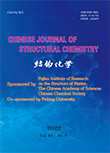Synthesis, Crystal Structure and Fe3+ Recognition of a Fluorescent Probe Based on Quinazolinone Derivative
WANG Lin, WANG Xiao-Feng, XUE Meng-Wei, DUAN Shu-Rong, LI Ting, YU Zhen-Zhen and ZHANG Dun-Lin*
Chin. J. Struct. Chem. 2022, 41, 2203055-2203061 DOI: 10.14102/j.cnki.0254-5861.2011-3325
March 15, 2022
quinazolinone, crystal structure, fluorescent probe
ABSTRACT
A novel quinazolinone derivative ethyl
2-(2-methyl-4-oxo-1,2,3,4-tetrahydroquinazolin-2-yl) acetate (EMOTA) was synthesized and characterized by HRMS, 1H
NMR, 13C NMR spectroscopy and X-ray crystallography, and the ion recognition performance
of the compound was studied by fluorescence analysis measurements. The
results showed that probe EMOTA has a rapid fluorescence response, good
selectivity and sensitivity to Fe3+. When the concentration of Fe3+ was in the range of 0~10.0 × 10-5 mol/L, the fluorescence
quenching could be affected by the probe, and the detection limit was 1.65 × 10-6 mol/L. In addition, the identification and detection of Fe3+ in
water samples were studied, and the results showed that probe EMOTA has high
efficiency, significant sensitivity and high selectivity on the recognition and
detection of Fe3+ in water samples, which indicates probe EMOTA has
a practical application prospect.








